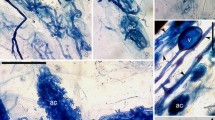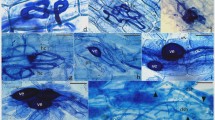Abstract
We investigated roots of 107 medicinal and aromatic plants (MAPs) in the Western Ghats region of Southern India for arbuscular mycorrhizal (AM) and dark septate endophyte (DSE) associations. Of the 107 MAPs belonging to 98 genera in 52 families examined, 79 were AM and 38 harbored a DSE association. Typical Arum- and Paris-type mycorrhizas are first reported in the presumed nonmycorrhizal family Amaranthaceae. Similarly, DSE associations are recorded for the first time in nine plant families and 37 plant species. Thirty MAPs had both AM and DSE associations. The number of MAPs having Arum-type mycorrhiza was greater than those having Paris-type. This was more prominent among herbaceous plants than in trees where the Paris-type was predominant. Similarly, the Arum-type was more prevalent in annuals than in perennials. DSE associations were more frequent in herbs and perennials compared to other MAPs.



Similar content being viewed by others
References
Ahlich K, Sieber TN (1996) The profusion of dark septate endophytic fungi in non-ectomycorrhizal fine roots of forest trees and shrubs. New Phytol 132:259–270
Ahulu EM, Nakata M, Nonaka M (2005) Arum- and Paris-type arbuscular mycorrhizas in a mixed pine forest on sand dune soil in Niigata Pretecture, central Honashu, Japan. Mycorrhiza 15:129–136
Barrow JR (2003) A typical morphology of dark-septate fungal root endophytes of Bouteloua in arid southwestern USA rangelands. Mycorrhiza 13:239–247
Barrow JR, Havsrtad KM, McCaslin BD (1997) Fungal root endophytes in fourwing saltbush, Atriplex canescens on arid rangelands of southwestern USA. Arid Soil Res Rehabil 11:177–185
Barrow JR, Osuna P (2002) Phosphorus solubilization and uptake by dark septate fungi in fourwing saltbush, Atriplex carescens (Pursh) Nutt. J Arid Environ 51:449–459
Baylis GTS (1975) The magnoloid mycorrhiza and mycotrophy in root systems derived from it. In: Sanders FE (ed) Endomycorrhizas. Academic, New York, pp 373–389
Brundrett MC, Kendrick B (1988) The mycorrhizal status, root anatomy and phenology of plants in sugar maple forest. Can J Bot 66:1153–1173
Brundrett MC, Kendrick B (1990a) The roots and mycorrhizas of herbaceous woodland plants. I. Quantitative aspects of morphology. New Phytol 114:457–468
Brundrett MC, Kendrick B (1990b) The roots and mycorrhizas of herbaceous woodland plants. II. Structural aspects of morphology. New Phytol 114:469–479
Bukhari MJ, Khade SW, Jaiswal V, Gaonkar UC, Rodrigues BF (2003) Arbuscular mycorrhizal (AM) status of tropical medicinal plants: a field survey of arbuscular mycorrhizal fungal association in herbs. Plant Arch 3:167–174
Cavagnaro TR, Gao L-L, Smith FA, Smith SE (2001) Morphology of arbuscular mycorrhizas is influenced by fungal identity. New Phytol 151:469–475
Davis DJ (1962) Emission and absorption spectrochemical methods. In: Peach K, Tracey MV (eds) Modern methods of plant analysis. Springer, Berlin Heidelberg New York, pp 1–25
Dixit RD (1984) (ed) A census of the Indian pteridophytes. Botanical Survey of India, New Delhi, India
Farnsworth NR, Soejarto DD (1991) Global importance of medicinal plants. In: Akerele O, Heywood V, Synge H (eds) The conservation of medicinal plants. Cambridge University Press, Cambridge, UK, pp 25–51
Gerdemann JW (1965) Vesicular-arbuscular mycorrhizas formed on maize and tulip tree by Endogone fasciculata. Mycologia 57:562–575
Helgason T, Fitter AH, Young JPW (1999) Molecular diversity of arbuscular mycorrhizal fungi colonizing Hyacinthoides non-scripta (blue bell) in a seminatural woodland. Mol Ecol 8:659–666
Henry AN, Kumari GR, Chitra V (eds) (1987) Flora of Tamil Nadu, India, vol 2. Botanical Survey of India, Coimbatore, India
Henry AN, Chitra V, Balakrishnan NP (eds) (1989) Flora of Tamil Nadu, India, vol 3. Botanical Survey of India, Coimbatore, India
Imhof S, Weber HC (1997) Root anatomy and mycotrophy (AM) of the achlorophyllous Voyria truncata (Standley) Standely & Steyermark (Gentianaceae). Acta Bot 110:127–134
Imhof S, Weber HC (2000) Root structures and mycorrhiza of the achlorophyllus Voyria obconica Progel (Gentianaceae). Symbiosis 29:209–211
Jacquelinet-Jeanmougin S, Gianinazzi-Pearson V (1983) Endomycorrhizas in the Gentianaceae. I. The fungus associated with Gentiana lutea L. New Phytol 95:663–666
Jakson ML (ed) (1971) Soil chemical analysis. Prentice Hall, New Delhi
Jumpponen A (2001) Dark septate endophytes—are they mycorrhizal? Mycorrhiza 11:207–211
Jumpponen A, Trappe JM (1998) Dark septate endophytes: a review of facultative biotrophic root-colonizing fungi. New Phytol 140:295–310
Khade SW, Bukhari MJ, Jaiswal V, Gaonkar UC, Rodeigues BF (2002) Arbuscular mycorrhizal status of medicinal plants: a field survey of AM fungal association in shrubs and trees. J Econ Taxon Bot 26:571–578
Koske RE, Gemma JN (1989) A modified procedure of for staining roots to detect VA mycorrhizas. Mycol Res 92:486–488
Kubato M, McGonigle TP, Hyakumachi M (2005) Co-occurrence of Arum- and Paris-type morphologies of arbuscular mycorrhizae in cucumber and tomato. Mycorrhiza 15:73–77
McGonigle TP, Miller MH, Evans DG, Fairchild GL, Swan JA (1990) A method which gives an objective measure of colonization of roots by vesicular–arbuscular mycorrhizal fungi. New Phytol 115:495–501
Miller RM, Smith CI, Jastrow JD, Bever VD (1999) Mycorrhizal status of the genus Carex (Cyperaceae). Am J Bot 86:547–553
Muthukumar T, Udaiyan K (2000) Arbuscular mycorrhizas of plants growing in the Western Ghats region, Southern India. Mycorrhiza 9:297–313
Muthukumar T, Udaiyan K (2001) Vesicular arbuscular mycorrhizal association in medicinal plants of Maruthamalai Hills, Western Ghats, Southern India. J Mycol Plant Pathol 31:180–184
Muthukumar T, Udaiyan K (2002a) Seasonality of vesicular–arbuscular mycorrhizae in sedges in a semi-arid tropical grassland. Acta Oecol 23:337–347
Muthukumar T, Udaiyan K (2002b) Arbuscular mycorrhizas in cycads of Southern India. Mycorrhiza 12:213–217
Muthukumar T, Sha L, Yang X, Cao M, Tang J, Zheng Z (2003) Mycorrhiza of plants in different vegetation types in tropical ecosystems of Xishuanbanna, southwest China. Mycorrhiza 13:289–297
Nair NC, Henry AN (eds) (1983) Flora of Tamil Nadu, India, vol 1. Botanical Survey of India, Coimbatore, India
Neeraj Shanker A, Mathew J, Varma A (1991) Occurrence of vesicular–arbuscular mycorrhizae with Amaranthaceae in soils of the Indian semi-arid region. Biol Fertil Soils 11:140–144
Newsham KK (1999) Phialophora graminicola, a dark septate fungus, is a beneficial associate of the grass Vulpiaciliata ssp. ambigua. New Phytol 144:517–524
O’Connor PJ, Smith SE, Smith FA (2001) Arbuscular mycorrhizal associations in the Southern Simpson Desert. Aust J Bot 49:493–499
Piper CS (ed) (1950) Soil and plant analysis. Interscience, New York, USA
Prain D (ed) (1981a) Bengal plants, vol 1. Bishen Singh Mahendra Pal Singh, Dehradun, India
Prain D (ed) (1981b) Bengal plants, vol 2. Bishen Singh Mahendra Pal Singh, Dehradun, India
Ruotsalainen AL, Väre H, Vesterg M (2002) Seasonality of root fungal colonization in low-alpine herbs. Mycorrhiza 12:29–36
Satija CK, Bir SS (eds) (1985) Polypodiaceous ferns of India. Today and Tomorrow’s Printers and Publishers, New Delhi, India
Schenck NC, Perez Y (eds) (1990) Manual for the identification of VA mycorrhizal fungi. Synergistic, Gainesville, FL
Sen AN (1998) Harnessing of soil microorganisms for the benefit of medicinal plants. In: Gautam PL, Raina L, Srivastava U, Rayachaudhuri SP, Singh BB (eds) Prospects of medicinal plants. Indian Society of Plant Genetic Resources, New Delhi, pp 275–280
Sieber TN (2002) Fungal root endophytes. In: Waisel Y, Amram E, Kafkafi U (eds) Plant roots: the hidden half. Marcel Dekker Inc, New York, USA, pp 887–917
Smith SE, Read DJ (eds) (1997) Mycorrhizal symbiosis. Academic, San Diego, CA
Smith FA, Smith SE (1997) Structural diversity in (vesicular)–arbuscular mycorrhizal symbioses. New Phytol 137:373–388
Tester M, Smith SE, Smith FA (1987) The phenomenon of non-mycorrhizal plants. Can J Bot 65:419–431
Tsuyuzaki S, Hase A, Niinuma H (2005) Distribution of different mycorrhizal classes on Mount Koma, northern Japan. Mycorrhiza 15:93–100
Udea T, Husoe T, Kubo S, Nakawashi I (1992) Vesicular arbuscular mycorrhizal fungi (Glomales) in Japan II: a field survey of vesicular arbuscular mycorrhizal association with medicinal plants in Japan. Trans Mycol Soc Japan 33:77–86
Urcelay C (2002) Co-occurrence of three fungal root symbionts in Gaultheria poeppigii DC in Central Argentina. Mycorrhiza 12:89–92
Van Tuinen D, Jacquot E, Zhao B, Gollotte A, Gianazzi-Pearson V (1998) Characterization of root colonization profiles by microcosm community of arbuscular mycorrhizal fungi using 25S r DNA targeted nested PCR. Mol Ecol 7:879–887
Vijayalakshmi M, Rao AS (1988) Vesicular–arbuscular mycorrhizal associations of some Asteraceae and Amaranthaceae. Acta Bot Indica 16:168–174
Yamato M, Iwasaki M (2002) Morphological types of arbuscular mycorrhizal fungi in roots of understorey plants in Japanese deciduous broadleaved forests. Mycorrhiza 12:291–296
Yu T, Nassuth A, Peterson RL (2001) Characterization of the interaction between dark septate fungus Philaocephala fortinni and Asparagus officinalis roots. Can J Microbiol 47:741–753
Author information
Authors and Affiliations
Corresponding author
Rights and permissions
About this article
Cite this article
Muthukumar, T., Senthilkumar, M., Rajangam, M. et al. Arbuscular mycorrhizal morphology and dark septate fungal associations in medicinal and aromatic plants of Western Ghats, Southern India. Mycorrhiza 17, 11–24 (2006). https://doi.org/10.1007/s00572-006-0077-2
Received:
Accepted:
Published:
Issue Date:
DOI: https://doi.org/10.1007/s00572-006-0077-2




